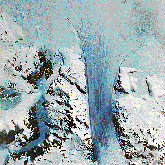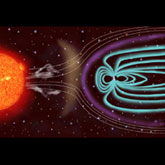What Causes Ice Ages....Or Global Warming?
 We know from the rock record and cores taken from polar ice caps that periods of global cooling (ice ages, or periods of glaciation) have alternated with warmer, more temperate periods having climates similar to what we now experience (interglacial periods). Graphs of the change in earth's average surface temperature over geologic time indicate that climate change has been ongoing throughout earth's history. It appears that climate change is the norm, and there is no one 'right' or normal surface temperature for earth. Our current, relatively warm climate appears to be a continuation of the norm with no indication that climate or surface temperatures will stabilize. Earth has experienced at least four major ice ages as well as several minor ones over its history. The last major ice age, which ended 10,000 to 12,000 years ago, was the only one that occurred during human existence, besides several more recent minor ice ages. Do humans affect earth's climate?
We know from the rock record and cores taken from polar ice caps that periods of global cooling (ice ages, or periods of glaciation) have alternated with warmer, more temperate periods having climates similar to what we now experience (interglacial periods). Graphs of the change in earth's average surface temperature over geologic time indicate that climate change has been ongoing throughout earth's history. It appears that climate change is the norm, and there is no one 'right' or normal surface temperature for earth. Our current, relatively warm climate appears to be a continuation of the norm with no indication that climate or surface temperatures will stabilize. Earth has experienced at least four major ice ages as well as several minor ones over its history. The last major ice age, which ended 10,000 to 12,000 years ago, was the only one that occurred during human existence, besides several more recent minor ice ages. Do humans affect earth's climate?
An ice age can begin when earth's average surface temperature drops by only 1 to 4 degrees C. Several variations in earth's dynamics appear to be able to initiate a warming or cooling trend. Earth is tilted on its rotational axis, and as it orbits the sun once a year in an elliptical path, different parts of the planet receive varying amounts of the sun's energy, and we experience changes in seasons. Like a spinning top, earth wobbles on its axis. This is called precession and causes one pole to at times lean farther away and the other pole to lean closer to the sun. This in turn can cause a winter or summer to be warmer or cooler than usual. Earth's orbital path is also a little different each year causing its distance from the sun, and thus the amount of radiant energy received, to vary.
Several other factors may contribute to climate change. Our solar system's position in the galaxy can result in earth receiving varying amounts of cosmic radiation from other stars. The constant movement of earth's crust (plate tectonics) causes different parts of the continents to move closer or farther from the equator thus affecting the average surface temperature as well as plant growth on the land. Volcanic eruptions can affect earth's atmosphere. Complex interactions in the carbon cycle can affect plant growth and the amount of carbon dioxide in the atmosphere. Ocean currents, such as the Gulf Stream in the Atlantic Ocean, play a big part in the distribution of heat around the planet, and any change in these currents could influence climate. So many variables are involved, and data are still required that reliable computer modeling of global climate has not yet been achieved.







